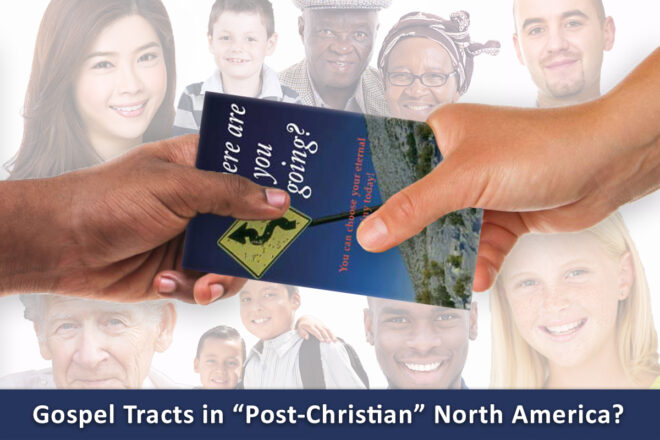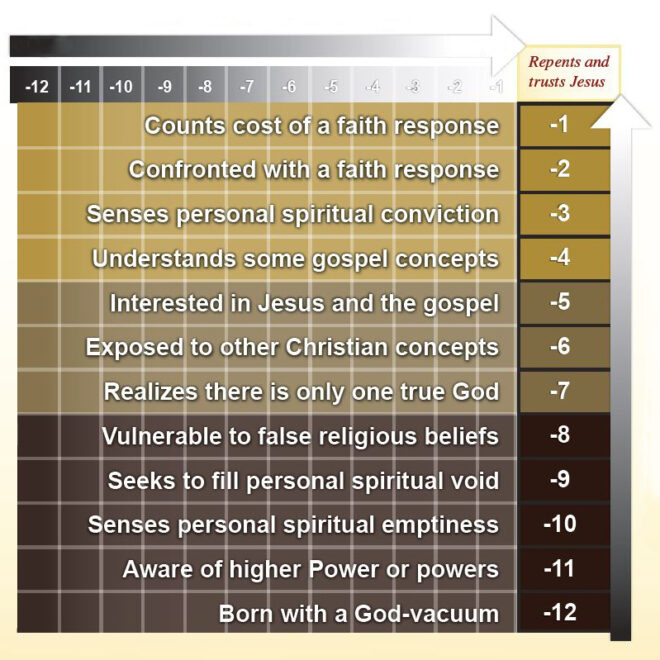Gospel Tracts in “Post-Christian” North America?

“God loves you and has a wonderful plan for your life.”
Who is this god and why would he (or she) care about me?
“Sin separates man from God.”
What is sin? Who is God? Why should I care?
“If you died right now, how certain are you that you would go to heaven?”
Heaven, where is that? How could I go anywhere after I’m dead? And why would I even want to go to a place I’ve never heard of?
These bold statements, and other similar statements and questions, are common lead-ins for gospel tracts published in North America and other parts of the world where Christianity has influenced (to some significant degree) vocabularies and worldviews, even of non-Christians. And countless thousands of men, women, boys, and girls have come to faith in Jesus Christ through these short and simple printed gospel presentations.
But, are they still effective today? For people who understand who God is, what sin is, and what heaven is all about, they may be as effective as ever before.
But what about immigrants from non-Christian religious cultures? What about recent generations of North Americans who have never attended church or Sunday school or vacation Bible school? What about young adults who attended secular schools where Bible reading and prayer was prohibited? What about people who have lived their entire lives in what is often called a “post-Christian” culture? How effectively does a typical tract communicate the gospel of Jesus Christ to Hindu, Buddhist, Muslim, or Postmodern North Americans? Generally, these people are going to be on one of the lower levels of our Good Soil Evangelism and Discipleship Scale:


How effective are traditional gospel tracts, those created in Quasi-Christian North America, for unbelievers who are at one of the lower levels on the Good Soil Evangelism and Discipleship Scale?
Four Spiritual Laws
Dr. Bill Bright, founder and former president of Campus Crusade for Christ (now called Cru), wrote the Four Spiritual Laws tract in the 1950s. Several years ago, Cru claimed that over one hundred million copies of the tract have been distributed, which probably makes it the most widely distributed gospel tract in the history of the Church. It has been translated “in all of the major languages of the world.” Countless numbers of people have professed faith in Jesus Christ by reading or being led through these Four Spiritual Laws:
- God loves you and offers a wonderful plan for your life.
- Man is sinful and separated from God.
- Jesus Christ is God’s only provision for man’s sin.
- We must individually receive Jesus Christ as Savior and Lord.
But Cru’s leaders now realize that the Four Spiritual Laws tract does not provide adequate Biblical content for this current generation of North Americans or internationals from other regions of the world.
As culture drifts further from a Christian worldview, communicating the gospel becomes more challenging. To understand Jesus Christ and what he has done is possible only when one understands the overall plan of the biblical story line.
To compensate for a general lack of Biblical knowledge in Cru’s target ministry cultures, the organization created a nine-panel (18 pages) unfolding tract titled Life@Large, which they, in 2010, revised and renamed: Backstory.
You might think of Backstory as the “Four Spiritual Laws” for a postmodern audience. The goal of Backstory is to tell the Bible’s story from beginning to end. There are seven themes with a brief paragraph introduction to each:
(1) Intimacy: Creation (2) Betrayal: The Fall and our sin (3) Anticipation: The Old Testament promise of a deliverer (4) Pursuit: The life of Christ (5) Sacrifice: His death and resurrection (6) Invitation: This age and the opportunity to turn back to God 7) Reunion: The age to come with judgment and eternal life.
Bridge to Life
Sometime early in his ministry, Dawson Trotman, founder of The Navigators, created a gospel presentation known as “Bridge to Life.”

The “Bridge,” as it was commonly referred to, was probably first used as an illustration that a gospel presenter would draw as he or she explained the gospel to an unbeliever. At some point, the bridge illustration was put into a gospel tract and began to be circulated widely to Christians outside of The Navigators.
Although the Bridge to Life gospel tract contains references to only nine Bible texts, it can be used effectively to explain the substitutionary death of Christ IF the gospel recipient has some basic knowledge about the Bible, the true God of the Bible, etc. But when dealing with unbelievers who know nothing of the truths of the Bible and Christianity, the gospel presenter will need to supplement the Bridge to Life by providing the overall Biblical context – the Bible’s BIG story - for the bridge illustration and its related Bible texts.
In 2008, Jerry White, previous international president of The Navigators, stated the he was aware that many non-Christians now need more Biblical context for the core elements of the gospel than is provided in the Bridge to Life.
Jerry White commented, "As Navigators we used to be able to lead a college freshman to Christ and by his sophomore year, we could disciple him or her to be winning and discipling others. But, not so now. Now, because of the post-Christian changes in our culture, it often takes three years to accomplish what we used to be able to do in one year."
Source: Paraphrase of a comment Jerry White made in Colorado Springs, Colorado to the leaders of ABWE.
Back to the Original Question
Are traditional gospel tracts created in North America adequately effective for presenting the gospel to unbelievers who are on the lower levels of the Good Soil Scale, the “Tilling Level”?
Answer: Probably not, if used without additional “backfilling.” Generally, gospel tracts do not provide enough Biblical context (the Bible’s overall storyline) for the brief gospel content contained in the tracts. If used properly as a “tool” by a trained personal evangelist, the evangelist can provide sufficient Biblical “backfilling” to supplement the tract’s content and compensate for its brevity and lack of Biblical breadth and depth. But just as a here-you-are-read-it tract, traditional gospel tracts do not clearly communicate the gospel of Jesus Christ to Biblically-illiterate unbelievers.
Previous articles in this series:
- Three Greek Verbs Define Good Soil
- Assessing Unbeliever’s Gospel Understanding
- Assessing Gospel Receptivity
- Initial Contact or Relational Evangelism—or Both?
- The Problem of Gospel Static
- One Gospel - Three Worldviews
- Worldview “Noisy” Neighborhoods
- How To Understand Worldviews: I’m an Onion – You’re an Onion
- How To Witness to A Non Believer: 3 Step Guide To Using Verbal & Non Verbal Communication
- Gospel Knowledge Deficiencies
- The Romans Road in “Post-Christian” North America?

The Story of Hope is an evangelistic Bible study workbook designed to help people who are open to dialogue at the investigative questions and core beliefs levels. And the FREE downloadable Leader’s Guide for The Story of Hope will guide you in the process of knowing how to evangelize unbelievers based upon a chronological Bible study of God’s overall redemptive story.



